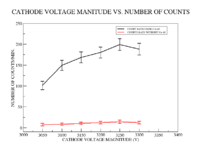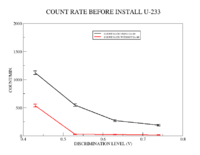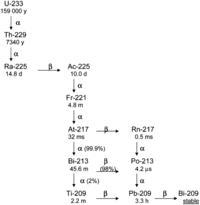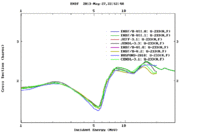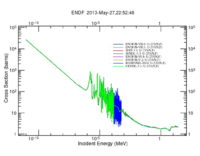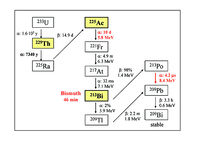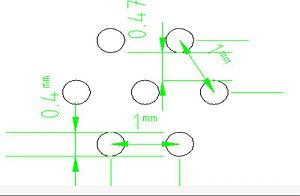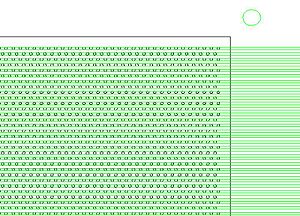Difference between revisions of "Neutron TGEM Detector Abdel"
| Line 220: | Line 220: | ||
[[GEM performance data graphs]] | [[GEM performance data graphs]] | ||
| − | |||
| − | |||
| − | |||
| − | |||
| − | |||
| − | |||
| − | |||
| − | |||
| − | |||
| − | |||
| − | |||
| − | |||
| − | |||
| − | |||
| − | |||
| − | |||
| − | |||
| − | |||
| − | |||
| − | |||
| − | |||
| − | |||
| − | |||
| − | |||
| − | |||
| − | |||
| − | |||
| − | |||
| − | |||
| − | |||
| − | |||
| − | |||
| − | |||
| − | |||
| − | |||
| − | |||
| − | |||
=U-233 fission x-section data= | =U-233 fission x-section data= | ||
Revision as of 23:58, 7 June 2013
THGEM#9 Counting Experiment test 1/4/13
The same setup above for THGEM#9 is used for a counting experiment.
The aim is to compare the number of counts in an hour for three different cases:
case 1-The alpha source's shutter is closed.
case 2- The alpha source's shutter is closed and a gamma source (Co-60) placed on the detector's entrance window.
case 3-The alpha source's shutter is open the gamma source is removed
case 4-The alpha source's shutter is open and a gamma source (Co-60) is placed on the detector's entrance window.
| V_cathode | THGEM_1T | THGEM_1B | THGEM_2T | THGEM_2B | THGEM_3T | THGEM_3B | |||
| 4200 | 2950 | 2450 | 500 | 1950 | 1200 | 750 | 950 | 100 | 850 |
- Experimental Setup
Trigout-> 474 ortec timing filter amp. -> EGG&G ESN CF4000-01 discriminator (5 mV threshold) -> tennelec TC534 counter and timer.
| case # | case 1 | case 2 | case 3 |
| counts/hr | 462 | 2400 | 2759 |
According to the number of counts in each case:
1- The detector detects cosmic rays (noise). (assuming the shutter stops all the alpha particles without any ionization)
2- The detector is sensitive to gamma rays (2400-462 = 1938)
3- The detector is sensitive to alpha particles (2759-462 = 2297) considering the same assumption above.
Discriminator level-count level relationship
| V_cathode | THGEM_1T | THGEM_1B | THGEM_2T | THGEM_2B | THGEM_3T | THGEM_3B | |||
| 4359 | 2950 | 2450 | 500 | 1950 | 1200 | 750 | 985 | 100 | 850 |
The following table represent the discriminator level and the count rate that is measured in 10 minute time interval with the shutter OPEN and 474 ortec timing filter amp. amplification is x6.
| discriminator level | Counts/min | |||||
|---|---|---|---|---|---|---|
| (mv) | Trial 1 | trial 2 | Trial 3 | Trial 4 | trial 5 | Ave err |
| 5 | 80.7 | 104.2 | 67.4 | 64.5 | 72.8 | |
| 7 | 96.6 | |||||
| 8 | ||||||
| 9 | 36.8 | |||||
| 10 | ||||||
| 12 | 11.2 | |||||
| 13 | ||||||
| 15 | 5.1 | |||||
| 18 | 3.7 | |||||
| 20 | 3.2 | |||||
| 50 | 0 | |||||
| 75 | 0.1 | |||||
| 100 | 0 | |||||
Counting Experiment using Leading Edge discriminator (Lecroy 623b)
The same setup above for THGEM#9 is used for a counting experiment.
The aim is to compare the number of counts for three different cases:
case 1-The alpha source's shutter is closed.
case 2- The alpha source's shutter is closed and a gamma source (Co-60) placed on the detector's entrance window.
case 3-The alpha source's shutter is open the gamma source is removed
case 4-The alpha source's shutter is open and a gamma source (Co-60) is placed on the detector's entrance window.
| V_cathode | THGEM_1T | THGEM_1B | THGEM_2T | THGEM_2B | THGEM_3T | THGEM_3B | |||
| 4200 | 2950 | 2450 | 500 | 1950 | 1200 | 750 | 950 | 100 | 850 |
The amplifier amplification affect the count rate, the follwing table shows the effect as the discrimination level is 1.19V :
| Amplification | Count rate (Count/min) |
| x10 | 1.37x10^7 |
| X6 | 1151 |
| x4 | 9 |
| x2 | 1 |
| x1 | 1 |
based on the above table, the amplification is chosen to be x6 for the measurement below.
| case # | case 1 | case 2 | case 3 | case 4 | Notes |
| counts/min | 1.55 x 10^7 | disc. level = 0.30V (700 mV sq.p-p) | |||
| counts/min | 2.08 x10^6 | disc. level = 0.53 mV (1.8V sq.p-p) | |||
| counts/min | 6902 | disc. level = 1.1 V (3V sq.p-p) | |||
| counts/min | 3222 | disc. level = 1.2 V | |||
| counts/min | 1469 | disc. level = 1.3 V | |||
| counts/min | 680 | disc. level = 1.4 V | |||
| counts/min | 113 | disc. level = 1.5 V | |||
| counts/min | 64 | 84 | disc. level = 1.62 V (4V sq.p-p) | ||
| counts/min | 10 | 11 | disc. level = 1.7 V | ||
| counts/min | disc. level = 1.8 V | ||||
| counts/min | 10 | 9 | disc. level = 1.9 V | ||
| counts/min | 7 | 9 | disc. level = 2 V |
Alpha-Beta detector counter
GEM before modification
GEM detector was operated without U-233 source inside the chamber, the detector's counting rate relationship with the applied voltage on the cathode was investigated and the result is shown by the following figure:
In the counting experiment, P.S. discriminator was used to discriminate againt the noise, the relationship between the count rate and the discrimination level (without changing the applied voltages on GEM cards and the cathode. The data is represented by the following figure:
The detector signal detected when the voltage on GEM HV-circuit was 2800V, but it was lower the noise, but raising up the voltage to 3000 V made the signal higher than the noise. So all the previous measurements observed ast he GEM HV-circuit was 3000V.
GEM after modification
A new cathode with thin layer of U-233 and its a FR4 shutter were added to the chamber, the distance of cathode is 8mm from the first GEM card, the distances between the GEM cards have equal distances to the ones before the modifications.
The VFAT connectors are connected together to provide the signal of the signal of the readout plate.
A signal is observed (on trigout and readout)as the voltage magnitude on the GEM HV-voltage circuit is 2800V, and the cathode is 3100V.
Prelimanry count rate measurements were recorded using 474 time filter amplifier, P.S. 710 discrimonator (at 0.7V) and a counter in the following table:
| Shutter location | Counts/min | |
|---|---|---|
| close | 2049 | 2500 |
| open | 6561 | 6360 |
The high rate of counts observed as the sutter is close is due to the U-233 beta decay as shown in the figure:
Two Counter Counting Experiment
Two counters were used for counting the detector signal after installing U-233 inside the detector. The signal detected by the trigout was an input for P.S. eight channel variable gain amplifier (model 777) that had two outputs fed two types discriminators; EG&G-EN CF4000 Constant Fraction Discriminator and P.S. octal leading edge discriminator (model 710). The discrimination level of each of them allowed one of the counters (ortec 875) to count for all the amplified signal pulses produced as the shutter was close, simultaneously, the second counter to count for them as the shutter was open. (The CFD D.V. was 0.025V and 6x 474 Ortec TFA , LED D.V. was 1.52V and 1x TFA)
Due to the lower pulse amplitude for the alpha particles the higher one for negative beta, decrease the detector gain may help in counting for alphas and fission fragments without counting for beta particles. Or we can use Ortec 552 (pulse shape analyzer and timer) with ortec 460 (delay shaping line amplifier).
Counting started by the lowest voltage alpha signal is observed (2.6 kV, 2.9 kV), an ortec 474 is used and it amplifies the signal up to 6x.A leading edge P.S. 710 octal discriminator is used with a discrimination level of 150 mV.
GEM performance data graphs
U-233 fission x-section data
What is the energy distribution of Beta and Photon from U-233
Gamma distribution for U-233 and its daughters are in metioned in details in the documents , File:U233 day gamma.pdf <ref>http://www.radiochemistry.org/periodictable/gamma_spectra , Wed. 04/10/2013</ref>
The energy range of the emitted gamma is shown in the following table .
| nuclide | Energy Minimum | Energy Maximum (keV) |
| U-233 | 25 | 1,119 |
| Ra-225 | 40 | 40 |
| Ac-225 | 10.5 | 758.9 |
| Fr-221 | 96.8 | 410.7 |
| At-217 | 140 | 593.1 |
| Bi-213 | 323.81 | 1,119.4 |
Negative beta particles are emitted mainly from U-233 daughters as shown in the figure <ref> http://itu.jrc.ec.europa.eu/index.php?id=204, Wed. 04/10/2013 </ref>
The following table shows the negative beta emitter nuclides,their parent nuclides, and their half lives:
| Nuclides | energy (MeV) | half life |
| 0.357 | 14d. | |
| 1.426 | 46min. | |
| 1.981 | 2.2 min. | |
| 0.644 | 3.25h | |
| 1.893 | stable |
What is the energy distribution after the 1 mm FR4 shutter
electrons
The energy distribution below represents the incidence electron on a 1 mm FR4 shutter.
The energy distribution of photons was observed on the opposite side of the shutter
Electrons (with least energy from U-233= 0.2 MeV) pass through the shutter have the energy distribution below.
photons
Number of ions produced from Beta and Photon in ArCo2
EMTest10 is used to calculate the average number of ions (electrons) when a 101 beta of 1 MeV are fired in a world that contains ArCO2. (13.5 per primary electron).
Calibrating GEM detector
The charge of the detector detected by the trigger output, the ADC distributes the charge over 4096 channel (12 bit CAEN V792). The aim is to calibrate the charge collected to the ADC channel number by injecting a known pulse in the wired electronics system used for detecting and processing the detector's charge.The following figure shows the the calibration curve.
- Amplifier effect on the signal
Ortec 474 timing filter amplifier amplifies the signal from the trigger output.The amplification will make a shift in the channel number compared to the same signal without application. To determine exactly the shift in channel number after the amplification, a choice for an input signal amplitude to charge the ADC just above noise, then amplifying the same input then recording the channel number (if possible). For example, generating a pulse of 0.1 V amplitude with an offset of 0.06 V using stanford research system pulse generator DG535 will hit channel 291 +_0.34 (run#4829), after the amplification it hits channel number 3767 +_0.78. Input pulse for the attenuator is 1.80V +_ 0.045, and the attenuator output pulse is 222 +_ 2.5 mV (factor of 8.1) when is set on 17.5 dB.
- 04/26/13
| Run Number | attenuation (dB) | Amplification | Average channel Number | Average channel Number - Noise (79) | calculated gain | Notes |
| 4853 | 0 | 0 | 880 | 801 | 0 | reference for the next two |
| 4854 | 2 | 0 | 553 | 474 | 4.6 | |
| 4855 | 4 | 0 | 304 | 225 | 11.0 | |
| 4860 | 0 | 0 | 3399 | 3320 | 0 | |
| 4861 | 14 | 0 | 98.46 | 19.46 | 44.6 | |
| 4862 | 0 | 0 | 3514 | 3435 | 0 | |
| 4863 | 14 | 0 | 133 | 54 | 36.1 | |
| 4868 | 0 | 0 | 3903 | 3824 | 0 | |
| 4869 | 14 | 0 | 114 | 35 | 40.8 | |
| 4872 | 0 | 0 | 2974 | 2895 | 0 | |
| 4846 | 24.5 | yes | 436 | 357 | 18.2 | |
| 4848 | 18 | yes | 1720 | 1641 | 4.9 | |
| 4849 | 20 | yes | 1213 | 1134 | 8.1 | |
| 4850 | 14 | yes | 3210 | 3131 | -0.7 | |
| 4851 | 16 | yes | 2365 | 2286 | 2.1 |
04/27/13
unamplified input pulse passed through an attenuator, the attenuation is changed (without changing the input pulse offset of the input), the results are in the following table:
| Run Number | attenuation (dB) | Average channel Number | Average channel Number - Noise (79) | calculated gain |
| 4894 | 0 | 3653 | 3574 | 0 |
| 4897 | 8 | 1104 | 1025 | 10.8 |
| 4898 | 9 | 916 | 837 | 12.6 |
| 4899 | 6 | 1531 | 1452 | 7.8 |
| 4898 | 3 | 2380 | 2301 | 3.8 |
04/28/13
- Amplified x4 level 4 fine gain
| Run Number | attenuation (dB) | Average channel Number | Average channel Number - Noise (79) | calculated gain |
| 4905 | 0 | 3779 | 3700 | 0 |
| 4906 | 3 | 2580 | 2501 | 3.4 |
| 4907 | 6 | 1776 | 1679 | 6.8 |
| 4908 | 9 | 1124 | 1045 | 10.9 |
| 4909 | 12 | 626 | 547 | 16.6 |
| 4910 | 15 | 287 | 208 | 25 |
| 4911 | 18 | 99 | 20 | 42.6 |
05/04/13
- Amplified x6 level 6 fine gain
- With attenuator
According to the calibration curve above the charge collected by the ADC is determined in the table above.[https://wiki.iac.isu.edu/index.php/Neutron_TGEM_Detector_Abdel#Run_List3 ]
05/10/13 & 06/03/13
The table below shows the measurements of the charge of a square pulse that has an amplitude of -0.49 V (osc. 0.504+_ 0 V )with a zero offset and a width of 25.2us. The gate width is 70ns.
| Run Number | attenuation (dB) | Average channel Number | Pedestal subtracted Average channel Number | calculated gain |
| 5120 | 0 | 3876.27 | 3797 | 0 |
| 5120 | 3 | 3057 | 2977 | |
| 5123 | 6 | 1906 | 1827 | |
| 5124 | 9 | 1339 | 1260 | |
| 5125 | 12 | 940 | 861 | |
| 5126 | 14 | 742 | 663 | |
| data2 06/03/13 | ||||
| 5172 | 0 | 3818.94 +/- 0.06 | ||
| 5173 | 3 | 2685.03 +/- 0.05 | ||
| 5174 | 6 | 1889.48 +/- 0.05 | ||
| 5176 | 9 | 1322.00 +/- 0.03 | ||
| 5177 | 12 | 926.62 +/- 0.03 | ||
| 5178 | 15 | 647.03 +/- 0.02 |
- Amplifier
An amplifier (x6 level 6) was added to amplify the signal before attenuation, a square pulse of an amplitude of (1st time-0.18V) and for (the second time 0.47V) (osc. 235 +_ 4 mV) with a zero offset and a width of 25.8us was used, the gate width was 70ns. After the amplification the signal amplitude is (first time 3.42+_ 0.29 V) (2nd time: gate integrate 4.21 +/-0 V).
| Run Number | attenuation (dB) | Average channel Number | Average channel Number - Noise (79) | charge collected (nC) | calculated attenuation | expected attenuation | V(mV) |
| 5134 | 14 | 3952 | 3873 | 1.6552 | 0 | 647+_32 | |
| 5135 | 15 | 3503 | 3424 | 1.4756 | 0.997 | 576+_27 | |
| 5136 | 18 | 2474 | 2395 | 1.064 | 20*log(3952/2472) = 4.2 | 4 | 416+_16 |
| 5137 | 21 | 1752 | 1673 | 0.7752 | 6.589 | 235+_ 32 | |
| 5138 | 24 | 1206 | 1127 | 0.5568 | 20*log(3873/1127) = 10.7 | 10 | 222 +_7 |
| Data2 | 06/03/13 Pedestal 63 | ||||||
| 5180 | 14 | 2872.76 +/- 0.09 | 872 | ||||
| 5181 | 15 | 2477.22 +/- 0.08 | 782 | ||||
| 5182 | 18 | 1823.29 +/- 0.08 | 546 | ||||
| 5183 | 21 | 1306.90 +/- 0.04 | 392 | ||||
| 5184 | 24 | 933.94 +/- 0.03 | 271 |
05/24/13
- ADC calibration using a battery
Using a 1.5V battery connected to to 5 kohm resistor, then 25 ohm terminated ADC. The oscilloscope measures 15 mV DC voltage for the battery as it is 50 ohm terminated.
| Run Number | channel Number | Channel Number - padestal | Gate width (ns) | Charge (nC) |
| 62 | 851 | 771 | 500 | 0.015*(Gate width)/25 = 0.3 |
| 63 | 1263 | 1184 | 750 | 0.45 |
| 64 | 1702 | 1623 | 1000 | 0.6 |
| 65 | 1250 | 2072 | 2151 | 0.75 |
| 66 | 2500 | 3897 | 3976 | 1.5 |
05/30/13
- ADC calibration using a battery
Using a 1.5V battery with a grounded positive terminal connected to to 5 kohm resistor, then 50 ohm terminated ADC. The oscilloscope measured 14.4 mV DC voltage of the battery when it is 50 ohm terminated.
| Run Number | channel Number +_ error | Gate width (ns) | charge (nC) |
| 97 | 865 +_ 0.04 | 500 | =0.0144*(Gate width=500)/50=0.144 |
| 98 | 493+_0.03 | 250 | 0.072 |
| 101 | 1283 +_0.03 | 750 | 0.216 |
| 102 | 1000 | ||
| 104 | 2105 +_ 0.04 | 1250 | 0.36 |
| 106 | 3317 +_ 0.02 | 2000 | 0.576 |
| 107 | overcharge | 2500 |
- Measurements Notes
1- The slope of the calibration curve as the ADC is connected to the battery with the positive terminal grounded is 178 pC.
2- The ADC manual manual mentioned 100pC gain/count, does count = channel? Also it is measures max. tolerate voltage >25 mV with +_ 2 mV as maximum voltage offset, the battery provides 14.4 mV offset, Does the ADC measure that the battery voltage or consider it more that the offset limit and measure only within the offset limit?
Today 05/31 the equipment moved to the LDS to start our measurements but I am still thinking how to improve our calibration curve measurements to get the right slope.
6/2/13
Measuring the grounded positive terminal battery output again in the LDS, V= 14.7 mV measured by the oscilloscope. (R= 5kohm, V=1.5, I= 1.5/5kohm = 0.3 mA, oscilloscope channel 2 is 46 ohm terminated, then V = 46*0.3mA = 13.8 mV). The ADC noise level in channel 5 (signal channel) is 63 (run #5162) which is 42.1 ohm terminated.
| Run Number | channel Number +_ error | channel Number - Pedestal | Gate width width (ns) | charge (pC) |
| 5161 | 356.14 +/- 0.01 | 293 | 178 | = 14.7*(Gate width)/42.1 = 62.2 |
| 5163 | 712.09 0.02 | 649 | 398 | 139.0 |
| 5164 | 1368.60 +_ 0.02 | 1305 | 798 | 278.6 |
| 5165 | 2662.70 +_ 0.02 | 2600 | 1592 | 555.9 |
| 5157 | 3670 +_ 0.01 | 3607 | 2216 | 773.8 |
06/04/13
- Amplified x6 level 6 fine gain
stanford pulse generator is used as source for a negative pulse of width of 11.8us +/- 3, and the gate width is 32.94 ns +/- 0.02 . all the voltage measurement is recorded by using oscilloscope 46 ohm terminated. So the amplifier input current is (input signal amplitude/46)
| Run Number | input signal (mV) | amplified pulse amp. (mV) +/- SD | Charge (pC) | Average channel Number | Average channel Number - Noise (63) |
| 5205 | 51 +/- 1 | 676.702 | 945 +/- 8 | 2415.57 +/- 0.13 | 2352.57 |
| 5207 | 56 +/- 1 | 744.730 | 1040 +/- 8 | 2644.05+/- 0.10 | 2581.05 |
| 5208 | 60 +/- 1 | 809.178 | 1130 +/- 10 | 2840.40+/- 0.15 | 2777.40 |
| 5209 | 65 +/- 1 | 859.304 | 1200 +/- 8 | 3066.89+/- 0.18 | 3003.89 |
| 5210 | 70 +/- 1 | 916.591 | 1280 +/- 8 | 3293.51+/- 0.21 | 3230.51 |
| 5214 | 80 +/- 1 | 1045.49 | 1460 +/- 8 | 3744.33+/- 0.15 | 3681.33 |
06/06/13
- Amplified x6 level 6 fine gain and P.S. gain amplifier 777
stanford pulse generator is used as source for a negative pulse of width of 892 ns +/- 4, and the gate width is 32.7 ns +/- 0.6 . all the voltage measurement is recorded by using oscilloscope 46 ohm terminated. So the amplifier input current is (input signal amplitude/46)
| Run Number | input signal (mV) | amplified pulse amp. (V) +/- SD | Charge (pC) | Average channel Number | Average channel Number - Noise (63) |
| 5253 | 21.6 +/- 0.3 | 0.79 +/- 0.01 | 1847.32 +/- 0.13 | ||
| 5254 | 23.6 +/- 0.3 | 0.86 +/- 0.01 | 2305.25 +/- 0.14 | ||
| 5255 | 25.6 +/- 0.3 | 0.94 +/- 0.01 | 2501.55 +/- 0.12 | ||
| 5256 | 27.6 +/- 0.3 | 1.02 +/- 0.01 | 2696.81 +/- 0.18 | ||
| 5257 | 29.6 +/- 0.3 | 1.09 +/- 0.01 | 2899.58 +/- 0.16 | ||
| 5258 | 37.3 +/- 0.3 | 1.40 +/- 0.01 | 3695.65 +/- 0.14 |
Time to observe the GEM signal
In the case of triple GEM detector with a gas flow of 0.3 SCFH and 2650V and 2950V on GEM cards and cathode successively, a signal lower than the noise (of 16 mV and amplified twice) is observed at 770.0s +/- 0.1.
The normal rate (8 MHz +/- 2 as measured by the oscilloscope) is observed after 952.9s +/- 0.1.
THGEM card tasks and tests
- New THGEM cards
Two new fully machined cards are going to be tested in air and ArCH4, if they passes 2000 V potential bwtween the top and the bottom, then they are going to be installed in ArCh4 gas chamber.
The older THGEM cards will have a high voltage enough to have one spark/min to clean impurities or surface defects.
References
THGEM design
THGEM#9
Media:Shalem_MSthesis_march2005.pdf
Media:Raz_Alon_MSthesis_Dec2007.pdf
Electric field Simulation
- Rim size dependence
File:THGEM Efield simulation.pdf
- 2010 THGEM design(s)
File:THGEM 2009 design gas efficiency.pdf
Simulations_of_Particle_Interactions_with_Matter
Voss and 3 russian references for Dy(n,x) cross sections
http://arxiv.org/abs/0903.3819 Dy photon gammas spectrum
http://www.ippe.obninsk.ru/podr/cjd/kobra13.php?SubentID=30974002
http://www.americanelements.com/thoxst.html
http://arxiv.org/pdf/physics/0404119
NIM_A535_2004_93[1]
File:NIM A590 2008 pg134 Eberhardt.pdf Prep Targets
Neutron cross sections for different elements Media:Neutron_cross_sections.pdf
http://www-nds.iaea.org/RIPL-2/
Media:n gamma cross sections at 25 keV.jpg
Media:n alpha cross section at 14.2 MeV.jpg
Media:ne cross section at 14 MeV.jpg
Media:high enegy fission x-section.jpg
Media:N_gamma_x-section_at_400_keV.jpg
Media:x-sections of reactions at 14 MeV.jpg
Media:n p x-section at 14.3MeV.jpg
Media: n gamma x-section at 14.5 MeV.jpg
Media: elastic x-section at 0.5 MeV.jpg
Media: n gamma x-section at 1 MeV.jpg
Media: n 2n x-section at 14.3 MeV.jpg
Donald James Hughes, Neutron cross sections, 2nd edition 1958, u.s.a atomic energy commission.Media:Neutron cross sections.pdf
File:NSAE 151 2005 319-334 Y.D. Lee.pdf
TGEM-2009 File:TGEM 2009.pdf
12 Volt power supply system.
http://www.lnf.infn.it/esperimenti/imagem/doc/NIMA_46128.pdf
http://electrontube.com.Media: rp097mono HV divier.pdf
http://www.cerac.com/pubs/proddata/thf4.htm#anchor550078
http://en.wikipedia.org/wiki/PC_board
GEANT4_Paticles_Models[2]
Resistors online store : http://www.justradios.com/rescart.html
RETGEMs
Media:Jinst8_02_p02012_THGEM_spark.pdf
- Thick GEM COBRA
Media: Nucl_Phys_B_Bidault_ novel UV photon detector.pdf
Media:Mauro micro pattern gaseuos detectors.pdf
Media:Development and First Tests of GEM-Like Detectors With Resistive Electrodes.pdf
http://www.supplydivision.co.uk/genitem.htm
Thick_GEM_versus_thin_GEM_in_two_phase_argon_avalanche_detectors (HV circuit)[3]
Stainless Steel deflection [4]
Data Sheets
radioactive surface cleaner NoCount MDSD File:Radioactive surface cleaner.pdf.
Th-Xsection references
File:Th-232 fxsection Behrens 0.7-1.4MeV.pdf
File:Th-232 fxsection Blons 1975 1.2-1.8MeV.pdf
File:Th-232 fxsection ermagambetov 0-3MeV.pdf
File:Th-232 fxsection Henkel 0-9MeV.pdf
File:Th-232 fxsection Ohsawa original.pdf
File:Th-232 fxsection pankratov 3-35MeV.pdf
File:Th-232 fxsection protopopov distancefromthesource.pdf
File:Th-232 fxsection rago 12.5-18MeV.pdf
U-238-Xsection and coating references
relative cross section and calibration samples characteristics for a well determined number of fissions per second
File:Eismont relative absolute nf induced intermediate energy.pdf
- U_238 cross section error analysis
INTERNATIONAL EVALUATION OF NEUTRON CROSS-SECTION STANDARDS, INTERNATIONAL ATOMIC ENERGY AGENCY,VIENNA, 2007 File:U238-xsection.pdf
U_238 (0.5-4MeV) and Th_232 (1-6MeV) fission cross section with statistical error.File:Th-232 U238 xsetion data ebars.txt
File:Pankratov fxsection Th232 U233 U235 Np237 U238 5-37MeV.pdf
Thorium Coating
ThF4 target for sputtering coatings
http://www.cerac.com/pubs/proddata/thf4.htm
Machining Uranium
Uranium will ignite in powder form
http://www.springerlink.com/content/rr072r52163x0833/
- coating Uranium
[[5]]
http://cat.inist.fr/?aModele=afficheN&cpsidt=16864172
Calorimeters/Detectors: DU sheet is in wide-scale use as an absorber material in high-energy physics research at large accelerator laboratories. The high atomic number and density of DU presents a large number of atoms per unit volume to interact with the particles emerging from collisions in these detectors. Also the slight background radiation from DU enables in situ calibration of the electronic read out devices within such detectors, thereby improving the accuracy of measurement.
http://www.2spi.com/catalog/chem/depleted-uranium-products.html
- IAEA Photonuclear Data Library [8]
- Data Acquisition
Warren_logbook[9]
Warren_Thesis [10]
Related To Gaseous Detectors
Breakdown and Detector Failure (10/21/10)
- Different kind of micro-pattern detectors
- References
1- A. Bressan, M. Hocha : NIM A 424 (1999) 321—342 File:High rate behavior and discharge limits in micro-pattern detectors .pdf
2- Fonte and Peskov IEEE 1999 :File:Fundamental limitations of high rate gaseous detectors.pdf
3- B. Schmidt: NIM A 419 (1998) 230—238 File:Microstrip gas chambers Recent developments radiation damage.pdf
Ideas
1.) Can we mix resistive paste (Encre MINICO) with TH-232. We construct a "bed of nails" to place a predrilled G-10 board with a copper border. The nails fill in the holes of the G-10 to keep the paste out. Ecre MINICO is a resistive paste used for transistors.
a.) Get some resistive paste.
http://www.leggesystems.com/p-253-elimstat-uxm-ccp.aspx
Resistive glue to compare
http://www.ellsworth.com/conformal.html?tab=Products
http://www.ellsworth.com/display/productdetail.html?productid=764&Tab=Products
http://www.ellsworth.com/display/productdetail.html?productid=2067&Tab=Products
http://www.cotronics.com/vo/cotr/ea_electricalresistant.htm
b.) mix with a metal similar to Th-232.
c.) construct bed of 0.4 mm nails. Look for 0.4 mm diameter pins.
7/31/2009
New vendor for carbon paste.
http://www.electrapolymers.com/productItem.asp?id=33
The data sheet does not show any information about the thickness of the paste.
The company has a distributor in the usa (877)-867-9668. A phone call is expected on Sat. 8/3/2009 about the availability of the product.
TGEM Mask Design
Coating U-238 or Th-232 is essential for neutron detection in the range 2-14 MeV, but THGEM contains holes that should be protected from any coating material. So, a mask is designed to cover these holes. The holes are in drilled to be on the corners of hexagonal of 1mm side length as in the figure:
The mask is made of stainless steel, 10 um laser tolerance with cut the plate to get the shape in the figure:
Please look at the following files for more details:
Make number bold black font. Add color so it is clear that they are holes in a material.
P_D
Performance of THGEM as a Neutron Detector
Vendor
Thick Film Screen Printers
http://www.sciquip.com/browses/browse_Cat.asp?Category=Screen+Printers
http://www.marubeni-sunnyvale.com/screen_printing.html
tektronix oscilloscope
134.50.3.73
<references/>
